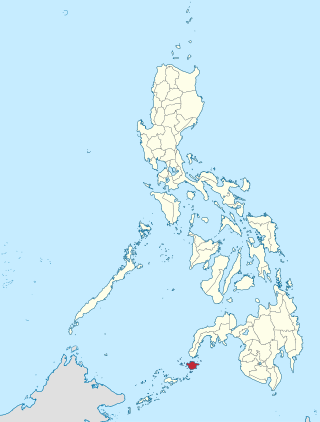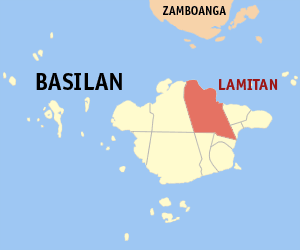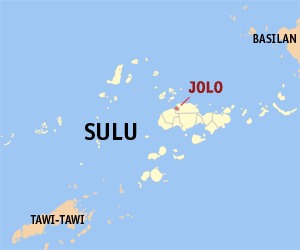
Abu Sayyaf, officially known by the Islamic State as the Islamic State – East Asia Province, is a Jihadist militant and pirate group that follows the Wahhabi doctrine of Sunni Islam. It is based in and around Jolo and Basilan islands in the southwestern part of the Philippines, where for more than four decades, Moro groups have been engaged in an insurgency seeking to make Moro Province independent. The group is considered violent and was responsible for the Philippines' worst terrorist attack, the bombing of MV Superferry 14 in 2004, which killed 116 people. The name of the group is derived from the Arabic abu, and sayyaf. As of April 2023, the group is estimated to have about 20 members, down from 1,250 in 2000. They use mostly improvised explosive devices, mortars and automatic rifles.

Khadaffy Abubakar Janjalani was a Filipino Islamist militant who was the leader of the Moro militant group known as Abu Sayyaf and the leader of one of its factions. He was a staunch Wahhabi follower.

Ipil, officially the Municipality of Ipil, is a 1st class municipality and capital of the province of Zamboanga Sibugay, Philippines. According to the 2020 census, it has a population of 89,401 people. Ipil is the most populous municipality of Zamboanga Sibugay, and the second most populous in Region IX after Sindangan.
The Dos Palmas kidnappings was a hostage crisis in southern Philippines that began with the seizing of twenty hostages from the affluent Dos Palmas Resort on a private island in Honda Bay, Palawan, by members of Abu Sayyaf on May 27, 2001, and resulted in the deaths of at least five of the original hostages. Three of these hostages were American citizens, Guillermo Sobero, and a married missionary couple, Gracia and Martin Burnham. At least 22 Filipino soldiers were killed in attempts to apprehend the captors and free the hostages in the 12 months following the initial hostage taking. An unknown number of captors were killed by government forces.

The Moro conflict was an insurgency in the Mindanao region of the Philippines, which involved multiple armed groups. Peace deals have been signed between the Philippine government and two major armed groups, the Moro National Liberation Front (MNLF) and the Moro Islamic Liberation Front (MILF), but other smaller armed groups continue to exist. In 2017, the peace council settled around 138 clan conflicts.

Jainal Antel Sali Jr. was a senior leader of Abu Sayyaf, an Islamist terrorist organization affiliated with Al Qaeda.

The 2007 Basilan beheading incident was an armed incident in July 2007 between the Moro Islamic Liberation Front (MILF) rebels and the Philippine Army which led to the execution of 14 or 23 members of the Philippine Marines, amongst them 11 beheaded in the province of Basilan in the southern Philippines.
The 2000 Sipadan kidnappings was a hostage crisis in Sabah, Malaysia, and the southern Philippines that began with the seizing of twenty-one hostages from the dive resort island of Sipadan at approximately 6:15 p.m. on 23 April 2000, by up to six Abu Sayyaf (ASG) bandits. Taken hostage were 10 tourists from Europe and the Middle East and 11 Malaysian resort workers, 19 non-Filipino nationals in total. The hostages were taken to an Abu Sayyaf base in Jolo, Sulu.

The Zamboanga City crisis or Zamboanga Siege was an armed conflict in Zamboanga City, Philippines between the government forces of the Philippines and Moro rebels from the Moro National Liberation Front (MNLF) that began on September 9, 2013 and ended twenty days later on September 28. The conflict began when MNLF rebels, under the command of Nur Misuari, attempted to occupy several coastal communities in Zamboanga City in protest of the Philippine government's failure to implement the 1996 final peace agreement with the MNLF.
This article contains a timeline of events from January 2015 to December 2015 related to the Islamic State of Iraq and the Levant (ISIL/ISIS). This article contains information about events committed by or on behalf of the Islamic State, as well as events performed by groups who oppose them.

The Battle of Tipo-Tipo was a military engagement that began on 9 April 2016 at Tipo-Tipo, Basilan Island, Philippines between forces of the Philippine Army and members of the Abu Sayyaf militant group. The battle resulted in dozens of casualties, with at least 18 soldiers and 31 militants reported killed, and more than 70 others injured. It was the largest single loss of life for the Philippine Army since the beginning of the year, and came just a day after the group had released an Italian hostage.
This article contains a timeline of events from January 2016 to December 2016 related to the IS-linked Abu Sayyaf. This article contains information about the events committed by or on behalf of the Abu Sayyaf, as well as events performed by groups who oppose them.
The following is a list of attacks which have been carried out by Abu Sayyaf, a militant group based in and around Jolo and Basilan islands in the southwestern part of the Philippines, where for more than four decades, Moro groups have been engaged in an insurgency for an independent province in the country.

The Maute group, also known as the Islamic State of Lanao, was a radical Islamist group composed of former Moro Islamic Liberation Front guerrillas and foreign fighters led by Christian Lucky Saligumba, the alleged founder of a Dawlah Islamiya, or Islamic state, based in Lanao del Sur, Mindanao, Philippines. The group, which a Philippine Army brigade commander characterized as terrorist, had been conducting a protection racket in the remote settlements of Butig, Lanao del Sur. This group follows the Wahhabi ideology and uses the book of Muhammad ibn Abd al-Wahhab called Kitab at-Tawhid in indoctrinating its followers. It had clashed on several occasions with Armed Forces of the Philippines troops, the most significant of which began in May 2017 and culminated in the Battle of Mactan.
Abu Sayyaf (ASG) is a radical Sunni Islamist group that has aggressively attacked civilians since the 1990s. It is notorious for beheading both military and civilian captives, especially when kidnap-for-ransom demands are not met. ASG victims include Filipino citizens as well as foreign nationals. Abu Sayyaf primarily operates in western Mindanao and the Sulu Archipelago of the southern Philippines.

The siege of Lamitan took place on 2 June 2001 when members of the Islamic terrorist group Abu Sayyaf entered the city of Lamitan, one of two Christian settlements in the predominantly Muslim province of Basilan in the Philippines. They took over a church and a hospital and held priests, medical staff and patients hostage. Government forces surrounded the Muslim extremists, preventing their escape. However, the Abu Sayyaf group managed to break out of the cordon by using their hostages as human shields.

The 2017 Bohol clashes were armed conflicts that took place in April and May 2017 between Philippine security forces and Moro ISIL-affiliated militants led by members of the Abu Sayyaf in Inabanga, Bohol, Philippines. Three Philippine Army soldiers, a policeman, four terrorists and two civilians were killed during the initial firefight. Subsequent firefights between the remaining militants and security forces resulted in the deaths of all the Abu Sayyaf insurgents. A ranking officer of the Philippine National Police linked to Abu Sayyaf attempted to rescue some of the insurgents but was arrested.

The siege of Marawi, also known as the Marawi crisis and the Battle of Marawi, was a five-month-long armed conflict in Marawi, Philippines, that started on May 23, 2017, between Philippine government security forces against militants affiliated with the Islamic State (IS), including the Maute and Abu Sayyaf Salafi jihadist groups. The battle also became the longest urban battle in the modern history of the Philippines.

The Summer 2016Sulu and Basilan clashes were armed conflicts that took place in two battlefronts on the southern islands of Mindanao, Philippines from 21 June to 12 July.
This is a chronology of the Moro conflict, an ongoing armed conflict in the southern Philippines between jihadist groups such as the Abu Sayyaf Group, the Maute Group, Jemaah Islamiyah, and Islamic State affiliates, mainstream separatist groups such as the Moro Islamic Liberation Front (MILF), the Moro National Liberation Front (MNLF) and the Bangsamoro Islamic Freedom Fighters (BIFF), and the Philippine Government since 1971. Much of the fighting has been concentrated on the island of Mindanao and the Sulu archipelago, with spillover incidents and attacks occurring in the Philippine capital Manila and neighboring countries such as Malaysia.












